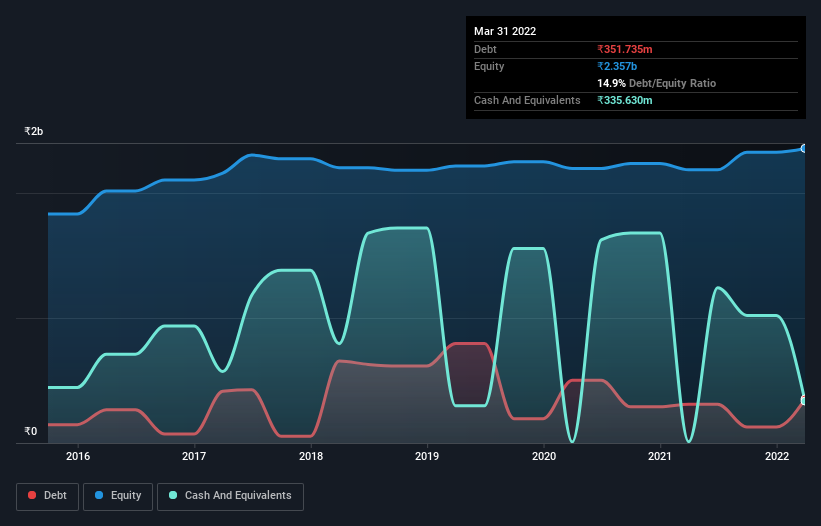[ad_1]
Howard Marks put it nicely when he said that, rather than worrying about share price volatility, ‘The possibility of permanent loss is the risk I worry about… and every practical investor I know worries about.’ So it might be obvious that you need to consider debt, when you think about how risky any given stock is, because too much debt can sink a company. We note that Kakatiya Cement Sugar and Industries Limited (NSE:KAKATCEM) does have debt on its balance sheet. But the real question is whether this debt is making the company risky.
What Risk Does Debt Bring?
Debt is a tool to help businesses grow, but if a business is incapable of paying off its lenders, then it exists at their mercy. Part and parcel of capitalism is the process of ‘creative destruction’ where failed businesses are mercilessly liquidated by their bankers. However, a more common (but still painful) scenario is that it has to raise new equity capital at a low price, thus permanently diluting shareholders. Of course, plenty of companies use debt to fund growth, without any negative consequences. When we think about a company’s use of debt, we first look at cash and debt together.
View our latest analysis for Kakatiya Cement Sugar and Industries
What Is Kakatiya Cement Sugar and Industries’s Net Debt?
The image below, which you can click on for greater detail, shows that at March 2022 Kakatiya Cement Sugar and Industries had debt of ₹351.7m, up from ₹309.4m in one year. However, it also had ₹335.6m in cash, and so its net debt is ₹16.1m.

How Strong Is Kakatiya Cement Sugar and Industries’ Balance Sheet?
The latest balance sheet data shows that Kakatiya Cement Sugar and Industries had liabilities of ₹668.6m due within a year, and liabilities of ₹95.2m falling due after that. Offsetting these obligations, it had cash of ₹335.6m as well as receivables valued at ₹276.9m due within 12 months. So it has liabilities totalling ₹151.4m more than its cash and near-term receivables, combined.
Of course, Kakatiya Cement Sugar and Industries has a market capitalization of ₹1.72b, so these liabilities are probably manageable. Having said that, it’s clear that we should continue to monitor its balance sheet, lest it change for the worse. But either way, Kakatiya Cement Sugar and Industries has virtually no net debt, so it’s fair to say it does not have a heavy debt load!
In order to size up a company’s debt relative to its earnings, we calculate its net debt divided by its earnings before interest, tax, depreciation, and amortization (EBITDA) and its earnings before interest and tax (EBIT) divided by its interest expense (its interest cover). The advantage of this approach is that we take into account both the absolute quantum of debt (with net debt to EBITDA) and the actual interest expenses associated with that debt (with its interest cover ratio).
Kakatiya Cement Sugar and Industries has very little debt (net of cash), and boasts a debt to EBITDA ratio of 0.072 and EBIT of 15.9 times the interest expense. Indeed relative to its earnings its debt load seems light as a feather. Even more impressive was the fact that Kakatiya Cement Sugar and Industries grew its EBIT by 237% over twelve months. That boost will make it even easier to pay down debt going forward. When analysing debt levels, the balance sheet is the obvious place to start. But you can’t view debt in total isolation; since Kakatiya Cement Sugar and Industries will need earnings to service that debt. So if you’re keen to discover more about its earnings, it might be worth checking out this graph of its long term earnings trend.
Finally, while the tax-man may adore accounting profits, lenders only accept cold hard cash. So we always check how much of that EBIT is translated into free cash flow. In the last two years, Kakatiya Cement Sugar and Industries’s free cash flow amounted to 45% of its EBIT, less than we’d expect. That’s not great, when it comes to paying down debt.
Our View
Happily, Kakatiya Cement Sugar and Industries’s impressive interest cover implies it has the upper hand on its debt. And the good news does not stop there, as its EBIT growth rate also supports that impression! Looking at the bigger picture, we think Kakatiya Cement Sugar and Industries’s use of debt seems quite reasonable and we’re not concerned about it. While debt does bring risk, when used wisely it can also bring a higher return on equity. There’s no doubt that we learn most about debt from the balance sheet. However, not all investment risk resides within the balance sheet – far from it. To that end, you should learn about the 3 warning signs we’ve spotted with Kakatiya Cement Sugar and Industries (including 1 which doesn’t sit too well with us) .
Of course, if you’re the type of investor who prefers buying stocks without the burden of debt, then don’t hesitate to discover our exclusive list of net cash growth stocks, today.
Have feedback on this article? Concerned about the content? Get in touch with us directly. Alternatively, email editorial-team (at) simplywallst.com.
This article by Simply Wall St is general in nature. We provide commentary based on historical data and analyst forecasts only using an unbiased methodology and our articles are not intended to be financial advice. It does not constitute a recommendation to buy or sell any stock, and does not take account of your objectives, or your financial situation. We aim to bring you long-term focused analysis driven by fundamental data. Note that our analysis may not factor in the latest price-sensitive company announcements or qualitative material. Simply Wall St has no position in any stocks mentioned.
[ad_2]
Source link








